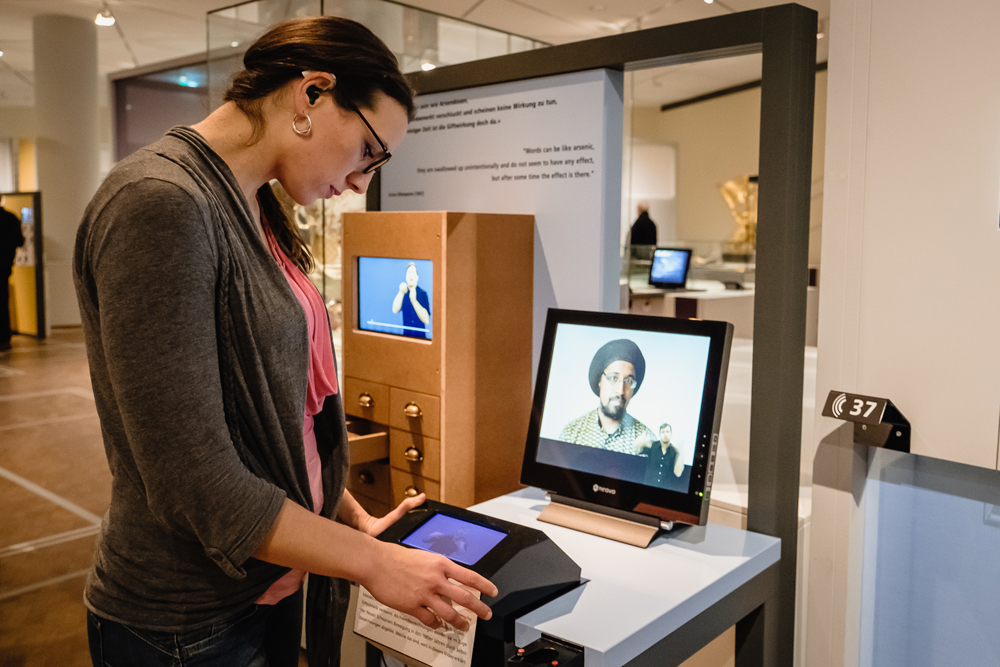
The Empathetic Museum: How Art Can Reach Everyone
The United Nations proclaimed 3 December the “International Day of Persons with Disabilities”. Since 2014 the Deutsches Historisches Museum has increasingly worked to develop its offerings and make its exhibitions accessible to all visitors. The most recent exhibition, “1917. Revolution. Russia and Europe” continues this initiative. Inclusive offers in the exhibition invite visitors to engage in a participatory introduction to each topic, and provide information in German and English, as well as Braille, plain language, and sign language (in video format). In her column for the International Day of Persons with Disabilities, Nadia S. Zaboura illuminates the new channels for communication and outreach which empathetic museums and other cultural institutions are adopting.
Stephen Wiltshire picks up his black pen and begins to draw. Out of the first delicate silhouettes he forms metre-long, detailed cityscapes on paper, capturing with astonishing accuracy the scenery of cities from New York City to Madrid, from Tokyo to Frankfurt. As an individual with autism and savant syndrome, Wiltshire can recreate a city’s appearance from memory with great artistic skill after only one stroll down a street or a single helicopter flight.
Many other artists with disabilities have made their mark on the world of art and culture, including notables like Ludwig van Beethoven, Vincent van Gogh and Henri de Toulouse-Lautrec.
Living with a disability often leads to the development of particular modes of perception and a unique view of the world, and also forces a critical examination of norms and areas of experience for which no code of norms exist, parameters that can facilitate creative potential in unique ways.
But what about the other side of the equation, the art viewers, the visitors without whom a museum is nothing?

People with hearing disabilities in the Deutsches Historisches Museum 2016 © visitBerlin, Foto Andi Weiland, Gesellschaftsbilder.de
We often have a particular image in mind when we think of the typical museum visitor, an image that by no means allows for as much diversity as is granted to artists. When we imagine wandering through art galleries, we don’t imagine meeting people with dementia, or people with impaired vision or physical disabilities. Or have you ever encountered someone with a white cane standing beside you “looking” at a Monet or Braque by way of an audio guide, or experiencing a Giacometti sculpture by touch?
Diversity as Normality
All cultural and educational institutions aspire to be places of openness and diversity, and not only in regards to the artists whose work they display. At the latest since the right to cultural participation was declared a human right in 2009, museums and exhibition organizers have increasingly focused on addressing a diverse public, not just ensuring the diversity of their collections.
What happens, though, when the great, exciting and necessary array of widely different people does not throng to our museums, when the characters who walk through the carefully arranged rooms are always the same?
What effects, conscious or unconscious, does this have on the curators’ work, on the choice of artworks and the orchestration of exhibits, the layout of the rooms, the lighting, or the way the works are hung? In short, what effect does this have on the way the art can be experienced?
When museums embark on new paths, taking upon themselves inclusive modes of operation and an inclusive ethos that encompasses all aspects of their work, they also open up the possibility to critically examine their own work and rediscover themselves. These museums present their exhibits differently, in new ways that allow them to be experienced more complexly. Exhibitions also often become more interactive. These museums finally also use their own structural diversity and the diversity of their personnel as the basis from which to initiate important discussions about norms and normality, difference and acceptance, fully in line with the museum’s role as “an institution in the service of society and of its development” as defined by the Code of Ethics of the International Council of Museums (ICOM).
Empathetic Exhibition Formats and Experiences
In order to simultaneously address an audience of individuals with and without disabilities we must first shift our perspective to take other modes of perception into account. In short, we need empathy. Let’s take a look at some current exhibition concepts and future scenarios that are truly empathetic in that they do not shut anyone out, but invite everyone to experience art:
• Artworks are described for the visually impaired. The narration itself becomes an art form in its own right, rendering colour palette, the elegance of a brushstroke, and the surface appearance of an object audible.
• Sculptures are made accessible to touch, allowing their forms to be actively explored, making it possible to experience art through the fingertips, for example through Augmented Touch and 3D reconstruction.
• Interpreters accompany guided tours, translating explanations and art-historical discussions of pictures into sign language. Visitors in the group or in the room who do not sign watch the hands’ expressive dance in fascination.
• Interpretations for various target audiences are added to the typical museum guide. Texts not only in various languages, but also customized and presented with various levels of complexity, from plain language to detailed art historical discussions, accommodate the needs of all visitors.
• Alongside the unparalleled ability to experience objects physically, digital modes of presentation enable new forms of participation, for example advance curation allowing older, less mobile individuals to arrange specific works of art into a personalized tour themselves.
Ideally these offerings should be identified, but not labelled as a “special” service. When public spaces like museums separate various groups into boxes using such labels, they also automatically segregate visitors linguistically as “non-conform” and “different”. This is exactly what empathetic museums avoid. As places of encounter they bring different target audiences together and welcome individuality and uniqueness. In few other places can the visitor simply be the way he is, without needing to prove anything or perform, or simply be alone with herself and her personal experience of the art, be inspired and leave the everyday world out there with its experiences of segregation far behind.
Most importantly, museums must develop diverse teams to work out new modes of display and outreach. Only then can we overcome our own blind spots and achieve empathy with diverse forms of perception and a truly inclusive experience as equals.
Literature
• ICOM – ICOM Code of Ethics for Museums
• United Nations – Universal Declaration of Human Rights, Article 27
• Tanja Praske – Do We Need Museums, Or Can They Go?
 |
Nadia S. Zabourais a freelance strategy and communications consultant and event moderator specialising in the field of economics, politics, and research. In addition to strategic and location consultancy in the markets of media, IT, games and health, she provides interdisciplinary expertise for the digital economy and society – as a specialised moderator and speaker (Fraunhofer, ZDF, ZKM, BMFSFJ etc.). In addition to this, Nadia S. Zaboura regularly manages and curates leading congresses (including SXSW Interactive, CREATIVE.HEALTH, Gamescom Congress). |